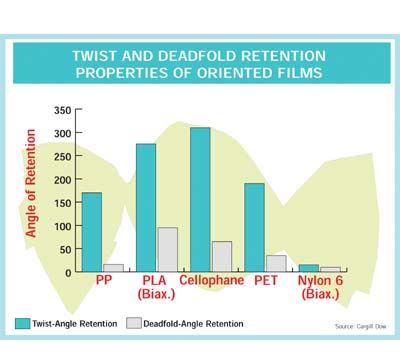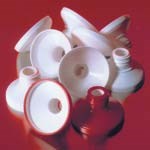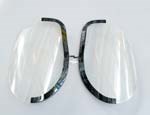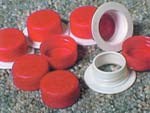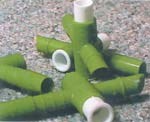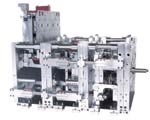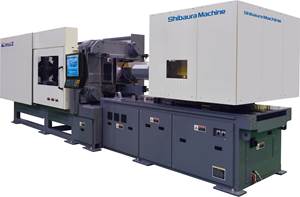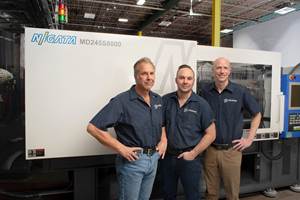Stack Molds Take on New Tasks
Conventional stack-mold designs are well known for their ability to outrace the productivity of conventional single-face molds.
Conventional stack-mold designs are well known for their ability to outrace the productivity of conventional single-face molds. Only rarely have they been used for other than fairly small, shallow-draw packaging and other disposable items. Yet a crop of new mold concepts introduced in the last few years are broadening the capabilities of stack designs to include multi-material molding and larger parts such as automotive headlamp lenses and side trim. Larger parts mean that stack molds are being run for the first time on presses larger than 1000 tons.
The pace of innovation has been particularly brisk in multi-component molding. Conventional single-face, multi-component molds typically inject one material into the cavities on half of the mold face and the second material into the other half. Between cycles, the rotary platen flips the mold on a horizontal axis. Stack molds multiply the number of usable mold faces and also permit molding the entire mold face with each material. The new designs have a center platen that rotates on a vertical axis. Depending on the system, the center component can have either two or four faces and rotate 90° or 180° each time the mold opens.
Four tooling concepts have commercialized this approach to high-volume production of multi-component parts. The new mold configurations include a rotary-platen design from Engel, in which the center platen has two faces and turns 180° each cycle. The Turning Stack Mold developed by Ferromatik Milacron Europe in partnership with German mold maker Foboha (which has a new U.S. representative) has a center platen with four faces that turns 90° each cycle. The Spin Stack approach from Gram Technology of Denmark can have as many as four small center stacks side by side, each with four faces and turning 90° per cycle. Another unique configuration, called Low Inertia Technology (LIT), comes from Caco-Pacific Corp. In this simpler design, a rotating bar with two core sets is attached to one half of each mold, rather than standing alone as in the other designs.
These new stack designs are being spurred on by soft-touch applications such as toothbrush handles, barrier-packaging applications, caps and closures with molded-in liners, multi-color cell-phone housings, and medical parts comprised of dissimilar materials such as PP and PVC.
One example comes from Foboha, which designed molds to produce 1 billion toothpaste-tube shoulders of HDPE (70 g) with a barrier layer of PET (40 g). Foboha has a patent on both the process and the product. This new 4 x 64 Turning Stack system spits out 64 two-layer parts in an 8.4-sec cycle. Output is estimated at 175 million units a year, so six production systems will be used. That volume would normally require 21 conventional stack molds and machines. Special shot-size controls permit adjusting PET layer thickness on the fly and help reduce part weight by 43%.
Consumer products like toothbrushes and razor handles with soft-touch features are growing in popularity, and the strong demand has pushed their volume requirements to levels for which stack molds are best suited. Ferromatik Milacron and Foboha have 50 to 60 Turning Stack molds in operation, as many as 20 of them in North America. The firm forecasts 10% annual market growth for multi-component parts.
"At the moment, the market for multi-component parts is absolutely booming," says Claus Ziegler, general manager at Kunststofftechnik Waidhofen A.D. Thaya (KTW), an Austrian supplier of molds for packaging and so far the only licensee of Gram's Spin Stack technology for caps and closures. "Five years ago, about 1% of our mold sales were for multi-component applications. Now they are 15% to 20% of our business," says Ziegler. KTW has eight to 10 Spin Stack molds in pilot or production phases.
Rotating stack styles
As compared with traditional rotary platens used for multi-component molding, the new rotary stack molds are all said to index much faster, owing to the lower mass of the turning member. This mass reduction is particularly evident in the case of Gram's Spin Stack (see cover illustration) and Caco-Pacific's Low Inertia system. "You typically can save 20% to 30% on the cycle time, and in special cases up to 50-80%," says KTW's Ziegler.
The Gram system has an added advantage in that it requires the least mold-opening distance to permit the stacks to spin. Managing director Jes Gram says a two-part closure mold needs to open just 100 mm for its system to index. A new ejector design being developed may reduce that daylight requirement to 60 mm.
"The Spin Stack concept is the most flexible on the market," adds Gram. "The turning mechanism, the hydraulics, and all of the components are contained in the mold, so this allows the technology to be used in any conventional press." The second material can be supplied from the side of the machine with a modular add-on injector, such as the new PlugExpress system from Windsor, which is sold in the U.S. by its sister firm, Sandretto.
Gram has extended its Spin Stack technology to what may be termed a double two-shot mold. Pictured on the cover of this issue, it's probably the most elaborate multi-component system yet. Designed for a two-component toothpaste shoulder, the tool has four parting lines and two pairs of Spin Stacks with four faces each, 24 cores per face, for a total of 384 cores and 192 cavities. Because the tool produces 96 finished parts per cycle, it may be termed a 2 x 48 system. With a cycle time of less than 7 sec, its output is 1.15 million parts/day, 390 million/yr.
Gram says the two-shot process can benefit production of thick parts with a single material. This approach allows the use of the same hot runner to inject the second layer of the same material. Better part quality may result, Gram says, because injection and cooling of a smaller volume of melt on each shot reduces the chances of sink marks.
With the Spin Stack approach, the non-molding (second and fourth) sides of the center stack can be used for insert loading or cooling without incurring a cycle-time penalty. Gram recently patented a new ejector system that can eject parts to the side of the machine. Hydraulics for the ejector are installed in the frame of the mold.
Another use for the additional stack faces is to mold a three-shot part. Gram has built a mold for a medical tubing connector with a first shot of PVC, a second shot of TPE, and a third shot of PVC to partially overmold the TPE. The parts were molded in three stations and ejected from the fourth. The demonstration was run on an 88-ton Demag machine in a cycle of less than 15 sec. The 8 + 8 + 8 cavity mold produces more than 46,000 parts/day for Carmo Industries in Denmark. (Gram, by the way, has worked closely with Demag since it came out with its first rotary stack mold in 1998.)
Ferromatik's and Foboha's jointly developed Turning Stack Mold appeared at last year's K 2001 show with the highest cavitation used to date in this system. The center cube of the 4 x 64 system had 64 cores on each of four faces and 64 cavities for each of two materials. The application was the toothpaste shoulder described earlier.
Although previous versions of the Turning Stack system had two center faces and 180° indexing, the new version with a center cube that indexes in 90° increments allows the non-molding sides to be used for cooling or inserting. A hydraulic motor indexes the center section in 1.3 sec with a programmable acceleration/deceleration profile.
The Turning Stack system runs only on Ferromatik's K-Tec line of machines. These units have a standardized option package for the stack-mold technology that provides longer tiebars to increase shut height and a more robust machine bed to support the turning center section. The second injection unit is positioned beside the turntable, perpendicular to the machine.
At K 2001, Engel introduced its rotary stack system, consisting of a Duo two-platen machine with a two-material stack mold having a 180°-indexing center platen. Engel offers its rotary stack mold only on the Duo machine because its shorter clamp allows mounting of the second injection unit on the back of the moving platen. That system greatly simplifies the runner design. Indexing speed is 1.5 sec or less.
So far, Engel has had one demonstration mold of this type built by High Tech Plastics AG in Austria. It illustrates the emerging opportunity for multi-component stack molds in automotive applications. At K 2001, Engel produced right and left headlight covers of clear polycarbonate with a black PC frame along one edge.
Unlike the others, Caco-Pacific's multi-shot technology is suited to conventional stack-mold designs that don't have a rotating center section. Its all-servo-driven LIT system separates the mold cores from the main body of the mold, fixing them on a rotating horizontal bar mounted on one mold face (see photo, p. 42). Two sets of cores are mounted on the bar—one set pointing up, the other pointing down. The bar is connected to one mold half by a guide rail. During molding, the cores are flush with the mold face. One material is injected into the upper row of cavities and a second material simultaneously fills the lower set, using two Caco-Pacific hot runners. When the clamp opens, the core bar slides away from the mold face to permit the core bar to rotate 180°. A stripper bar ejects the finished parts from the lower set of cores, and then the bar slides back against the mold face, and the mold closes.
The rotating core bar has relatively low mass and is turned by a small servo motor mounted on the end. Rotation takes less than 0.5 sec, says John W. Thirlwell, v.p. of sales and marketing. He notes that this system allows the second shot to fully encapsulate the first material, if desired.
Caco Pacific has built several LIT tools in less than two years. All of these are single-face tools, but stack-mold versions are now on order. The largest application to date is a 16 + 16 single-face mold producing pen barrels fully encapsulated with soft-touch overmolding. A two-material, 32 + 32 stack mold is being designed. Thirlwell says LIT has drawn considerable interest in medical markets because its all-electric operation is suited to clean rooms.
Multi-resin tricks
Sources at both Gram and Ferromatik/Foboha note that rotating stack molds lend themselves to a number of unusual applications. One is thermoplastic/thermoset, or "hot/cold" molding, where one material needs a hot mold to cure and the other needs a cold mold. Gram designed a 2 + 2 cavity Spin Stack mold for a nylon automotive part with an integral silicone-rubber gasket.
Although the goal in nylon/silicone molding is to achieve a good bond between the two, Gram and Ferromatik/Foboha have utilized the extra cooling potential of a four-faced rotating stack element to achieve the opposite effect. If the first part is cooled thoroughly enough prior to overmolding, the two components of the final part can slide freely against each other. Gram has demonstrated this in molding a valve with one part that slides inside the other (see photo, p. 47). Another example is molding screw caps together with spouts for gable-top juice cartons. The PP-copolymer caps are molded first; the cores are unscrewed; and then the LDPE spouts are molded inside the caps using a new set of cores. Because the caps are cooled for an extra cycle, and the second shot of LDPE has a lower melt temperature, the caps and spouts don't stick together.
Breaking the size barrier
For the first time, stack-mold technology has broken into larger parts molded on machines bigger than 1000 tons. Plastcoat, part of Decoma International in Mississauga, Ont., is using a Husky two-level stack mold with one cavity in each face to simultaneously produce front and rear wheel flares for Ford's XLT trucks. Another 1 + 1 stack mold is making rockers for Toyota's Camry line. The parts are each several feet long and use about 300 g of TPO. These parts are molded on Husky's 2200-ton EWLL (extra wide, long) two-platen machine.
"The primary benefit of the stack mold is floor-space savings," says Rebecca Branca, molding operations manager. Cycle times are generally consistent with the same tools running in two separate machines with the same tonnage capacity, she says.
The molds have a special sprue-bar design that runs underneath the mold. It distributes melt to the stack-mold carrier, which contains a special hot-runner system to feed two molds. Husky designed the runners so that the A and B sides of the melt system are balanced, even though the parts are different, says Roy Zinner, molding maintenance manager.
When the mold is open, the sprue bar splits in half, with one side connected to the stationary platen and one to the stack-mold carrier. A "harmony" bar draws all pieces of the mold together for clamping. The bar can be adjusted to suit different mold heights on both sides. Plastcoat produces about 600 parts per shift.
Related Content
Completely Connected Molding
NPE2024: Medical, inmold labeling, core-back molding and Industry 4.0 technologies on display at Shibaura’s booth.
Read MoreSlimmer All-Electric Press Debuts
A slimmed-down version of Engel’s all-electric, e-mac injection molding machine is among eight displays, which also include LSR micromolding, quick mold changes and a cube mold.
Read MoreCustom Injection Molder Plugs into All Electric Machines
Formerly a showroom for early-aughts-era Van Dorn hydraulics, the newest additions to Drummond Industries’ transforming fleet are all-electric Niigata injection molding machines.
Read More50 Years...600 Issues...and Still Counting
Matt Naitove marks his first half-century in plastics reporting, with a few of his favorite headlines.
Read MoreRead Next
Troubleshooting Screw and Barrel Wear in Extrusion
Extruder screws and barrels will wear over time. If you are seeing a reduction in specific rate and higher discharge temperatures, wear is the likely culprit.
Read MoreProcessor Turns to AI to Help Keep Machines Humming
At captive processor McConkey, a new generation of artificial intelligence models, highlighted by ChatGPT, is helping it wade through the shortage of skilled labor and keep its production lines churning out good parts.
Read MoreWhy (and What) You Need to Dry
Other than polyolefins, almost every other polymer exhibits some level of polarity and therefore can absorb a certain amount of moisture from the atmosphere. Here’s a look at some of these materials, and what needs to be done to dry them.
Read More



